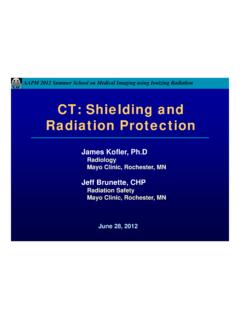Transcription of NCRP Recommendations for Ending Routine Gonadal …
1 National Council on radiation protection and Measurements7910 Woodmont Avenue / Suite 400 / Bethesda, MD 20814-3095 Recommendations for Ending Routine Gonadal Shielding During Abdominal and Pelvic RadiographyNCRP Statement No. 13, January 12, 2021 Executive SummaryThe purpose of radiological protection , including Recommendations for shielding, is to reduce the likelihoodof possible harm. For medical exposures, the goal is to keep exposures as low as reasonably achievable whilesimultaneously ensuring that the needed information is obtained.
2 Gonadal shielding (GS) was introduced andwidely recommended in the 1950s with the intent of minimizing the potential for heritable genetic effectsfrom medical exposures. Scientific evidence has led the National Council on radiation protection and Mea-surements (NCRP) to reconsider the recommendation for GS. Several factors contribute to NCRP s new rec-ommendation. The risks of heritable genetic effects are now considered to be much less than previously estimated. Improvements in technology since the 1950s have resulted in up to a 95 % reduction in the absorbeddose to pelvic organs from radiography.
3 GS can interfere with the use of automatic exposure control (AEC) and thereby cause an increase indose to other pelvic and abdominal organs that may be more radiosensitive. GS obscures portions of pelvic anatomy and may obscure important findings on radiographs. This limitsthe practical dimensions and area of the shield. Despite adherence to practice guidelines by technologists, GS may not completely shield the gonadsin the majority of patients due to the limited area of the shield and the normal variations in patientanatomy.
4 A substantial portion of Gonadal dose to the ovaries is delivered by scattered x rays that are not attenu-ated by a result, NCRP has concluded that in most circumstances GS use does not contribute significantly toreducing risks from exposure and may have the unintended consequences of increased exposure and lossof valuable diagnostic information, and therefore use of GS is not justified as a Routine part of now recommends that GS not be used routinely during abdominal and pelvic radiography, and thatfederal, state, and local regulations and guidance should be revised to remove any actual or implied require-ment for Routine GS.
5 GS use may remain appropriate in some limited circumstances. The Recommendations inthis Statement are limited to patient GS during abdominal and pelvic radiography. NCRP recognizes thatadoption of these new Recommendations requires addressing the impact of this substantial change oningrained medical imaging frequently uses ionizing radiation to provide information necessary for patient care. Thegoal of radiation protection in medical settings is to manage the radiation dose to the patient to be commensu-rate with the medical purpose.
6 Scientific understanding in the 1950s included the possibility of radiation -induced heritable effects. Consequently, the use of radioprotective shields placed over the expected location ofthe gonads was recommended or required in guidelines and regulatory standards. This Statement reevalu-ates the effectiveness of GS in light of technological advancements in medical imaging and current scientificevidence, including Gonadal radiosensitivity, in order to provide updated Recommendations regarding Rationale for the Use of Gonadal Shielding The widespread practice of radioprotective (more familiarly lead ) shielding of the male and femalegonads from the primary x-ray beam began in the 1950s (Magnusson 1952; ICRP 1955.)
7 Ardran and Kemp2 Statement1957; Abram et al. 1958), with evidence of a reduction in male Gonadal dose of up to 98 % (Ardran and Kemp1957; Feldman et al. 1958). In 1976, the Food and Drug Administration (FDA) introduced a recommenda-tion in the Code of Federal Regulations (FDA 2019) that shielding should be used to protect the gonadsfrom radiation exposure that may have genetic effects through mutations in germ cells (FDA 1976). The FDArecommendation was based on then-current scientific understanding that exposure to ionizing radiationcauses mutations in germinal tissue, which may adversely affect future generations, and the assumptionthat GS substantially limited the amount of ionizing radiation reaching the gonads during radiography (FDA1976).
8 Current state regulations vary but are most often derived from the 1976 FDA includes a requirement for GS during abdominal and pelvic radiography, with the exception that GSneed not be used for cases in which it would obscure anatomy of interest in the diagnostic of Patient Doses During RadiographyIn the first half of the 1950s, when beam filtration was typically < mm aluminum equivalence (Stanfordand Vance 1955), the entrance air kerma for an anterior-posterior radiograph of the abdomen and pelvis was11 to 12 mGy for an adult patient (Handloser and Love 1951) and mGy for an infant (Billings et al.)
9 1957).This corresponded to estimated Gonadal doses for unshielded patients of 10 to 11 mGy and 4 mGy for adultmales and females, respectively (Somasundaram et al. 2020). Three developments since the 1950s havedramatically reduced patient dose during diagnostic radiographic examinations (Huda et al. 2008): increasedx-ray beam filtration (Ardran 1956; Nickoloff and Berman 1993), improvements in x-ray generators (Sobol2002; Matsumoto et al. 1991), and faster image receptors (Rossi et al.
10 1976; Haus and Cullinan 1989). Theseadvances have reduced current typical Gonadal dose delivered by up to 95 % as compared to the doses deliv-ered in the 1950s (Jeukens et al. 2020).Factors Impacting the radiation -Reduction from Gonadal Shielding Ideal GS follows manually centered shields placed between the gonads and the x-ray source. Levels ofgonadal radiation dose reductions can differ when comparing ovaries and testes and can be substantial withideal shielding. However, shield placement is seldom ideal and can increase the radiation dose when used inconjunction with AEC.

